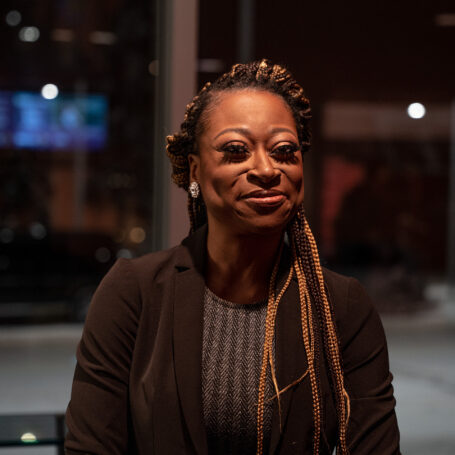January 19, 2023
What is Ribbon Rouge’s Black Equity in Alberta Rainforest project? It mobilizes data and research to bring meaningful change in health equity for African, Caribbean and Black Canadians
The Black Equity in Alberta Rainforest (BEAR) initiative began as a spin-off of a listening campaign run by Ribbon Rouge founder Moréẹnikéẹ Ẹniọlá Ọláòs·ebìkan. She went into the community, listening to the experiences and stories of African, Caribbean and Black (ACB) people.
“While she was listening with a group of other people, they realized the biggest gap towards achieving health equity was that there was no evidence-based information to support disparities being talked about,” says Funke Olokude, executive director of Ribbon Rouge. There were stories and shared experiences, but there was a lack of hard, actionable data.

So, Ribbon Rouge founded BEAR with the goal of mobilizing data and research to bring meaningful change in Black health equity. BEAR has seven subprojects running, with support from Edmonton Community Foundation (ECF), NorQuest College, University of Alberta, Mount Royal University and The King’s University.
“It is not just about filling a major knowledge gap in the ACB community,” says Olokude, “but also about supporting people to understand the complex contextual reality in which they lead their lives and thrive despite the odds.”
From the research, BEAR will produce 13 interdisciplinary reports and translate them into multimedia documents such as infographics and research posters. Olokude hopes this information will help bring accurate information about the ACB community to others and inspire solutions.
“Another issue with the stats that a lot of outside institutions collect across Canada is the fact that they lump all of us into ‘Black,’” Olokude says. “There’s diversity within the Black population, so when you lump all of us as ‘Black,’ you’re … prescribing the same solutions for all of us.”
Olokude says the research that has already been done shows that 58.8 per cent of the ACB population in Alberta are first- generation immigrants and 44 per cent of them came as refugees. When it comes to prescribing solutions, Olokude notes that there cannot be a one-size-fits-all solution.
She notes that the province of Alberta’s interactive health data portal does not have much information broken down by race. One exception is data on Human Immunodeficiency Virus (HIV), which shows that the ACB community seems to have a higher incidence of the disease.
“Though the information on social determinants of health is available, it would be important to have details by race,” says Viola Manokore, an instructor at NorQuest College and one of BEAR’s principal investigators. “Within ACB communities, it’s also important to acknowledge the diversity of the community and the health challenges they face. For example, immigrants versus refugees do face different challenges and lumping them together dilutes their needs.”
Manokore joined BEAR in the spring of 2022. Currently, she is working with a postdoctoral fellow on a scan of literature exploring health inequity issues in Alberta’s people of African descent. Manokore says being part of this initiative is humbling and brings lots of learning opportunities. She hopes the findings will provide insights about ACB health-related issues in Alberta and beyond.
“When it comes to health issues, I think the African philosophy of “Ubuntu” [I am because we are] does apply to issues of health. What affects one community has an impact on us all,” says Manokore. “COVID-19 was an excellent example of the importance of having holistic approaches to health in order to have a healthy population, regardless of identity.”
Lebogang Disele, a graduate research intern for subproject four of BEAR (ArtSpaces), hopes her work will set a strong foundation for Ribbon Rouge to keep using the arts to work in the community. Her subproject focuses on using community-based art to engage stakeholders, gather information and disseminate findings from other subprojects. Disele has assisted in creating a pilot of an interactive theatre piece. She is also working on creating a play from different stories collected from community members, which she hopes will be produced in 2023.
“I like being able to use theatre and art for social justice and development,” says Disele. “I hope through those projects we will develop a core of artists who support Ribbon Rouge in its work.”
Joseph Osuji is a professor at Mount Royal University and the principal investigator for the Community Development for HIV-related Equity subproject at BEAR. “I really like the collaboration with other universities and other researchers involved in the BEAR project,” Osuji says. “Most importantly, I am so proud of the work we have done so far in bringing to the forefront health disparities in Alberta and the experiences of minorities in accessing and delivering care.”
Olokude says BEAR is an ambitious project that needs funding to back it up. Edmonton Community Foundation committed $100,000 per year for three years to the project. That agreement is now in its second year.
“This journey to creating social innovative solutions for humanity is incomplete without those who first believe in you when it all looks impossible,” says Olokude. “We are grateful to ECF for believing in the vision of the BEAR.”
In year three, Olokude hopes to begin the knowledge synthesis phase, which will lead to reports being generated and the launch of the social innovation lab. It looks to build solutions from the ground up, driven by the people most impacted by the information gathered.
This article comes from the Winter 2022 edition of Legacy in Action. Read the full issue.